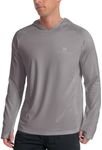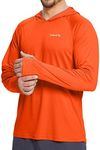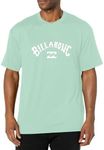Buying Guide for the Best Rash Guards
Rash guards are essential for protecting your skin from irritation, sunburn, and abrasions during water activities like surfing, swimming, and snorkeling. When choosing a rash guard, it's important to consider several key specifications to ensure you get the best fit and functionality for your needs. Understanding these specs will help you make an informed decision and enjoy your water activities comfortably and safely.MaterialThe material of a rash guard is crucial because it affects comfort, durability, and performance. Most rash guards are made from a blend of polyester and spandex or nylon and spandex. Polyester blends are generally more durable and resistant to chlorine, making them ideal for swimming pools. Nylon blends are softer and more flexible, providing greater comfort for activities like surfing. Choose a material based on the type of water activity you'll be engaging in and your personal comfort preferences.
FitThe fit of a rash guard can significantly impact your comfort and performance. Rash guards come in two main fits: tight (compression) and loose (relaxed). Tight-fitting rash guards are designed to stay close to the skin, reducing drag in the water and providing muscle support, which is beneficial for high-intensity activities like surfing or competitive swimming. Loose-fitting rash guards offer more comfort and freedom of movement, making them suitable for casual swimming or beachwear. Consider the intensity of your activity and your comfort level when choosing the fit.
UV ProtectionUV protection is an important feature of rash guards, especially if you spend a lot of time in the sun. Rash guards with a high UPF (Ultraviolet Protection Factor) rating, typically 50+, provide excellent protection against harmful UV rays, reducing the risk of sunburn and long-term skin damage. If you plan to be outdoors for extended periods, prioritize rash guards with high UV protection to keep your skin safe.
Seam ConstructionSeam construction affects the comfort and durability of a rash guard. Flatlock seams are commonly used in high-quality rash guards because they lie flat against the skin, reducing chafing and irritation. Overlock seams are more common in budget options and may be less comfortable for prolonged use. If you have sensitive skin or plan to wear the rash guard for extended periods, opt for flatlock seams to ensure maximum comfort.
Sleeve LengthRash guards come in various sleeve lengths, including short sleeve, long sleeve, and sleeveless. Short sleeve rash guards offer more freedom of movement and are ideal for warmer conditions. Long sleeve rash guards provide better coverage and protection from the sun and abrasions, making them suitable for cooler conditions or activities where you need more protection. Sleeveless rash guards are less common but can be a good option for maximum mobility and minimal coverage. Choose the sleeve length based on the climate and the level of protection you need.
SizeChoosing the right size is essential for comfort and performance. Rash guards should fit snugly but not be too tight. A well-fitting rash guard will stay in place during activity and provide the necessary support and protection. Refer to the manufacturer's size chart and consider your body measurements to find the best fit. If you're between sizes, consider the type of fit you prefer (tight or loose) and the material's stretchability.




















